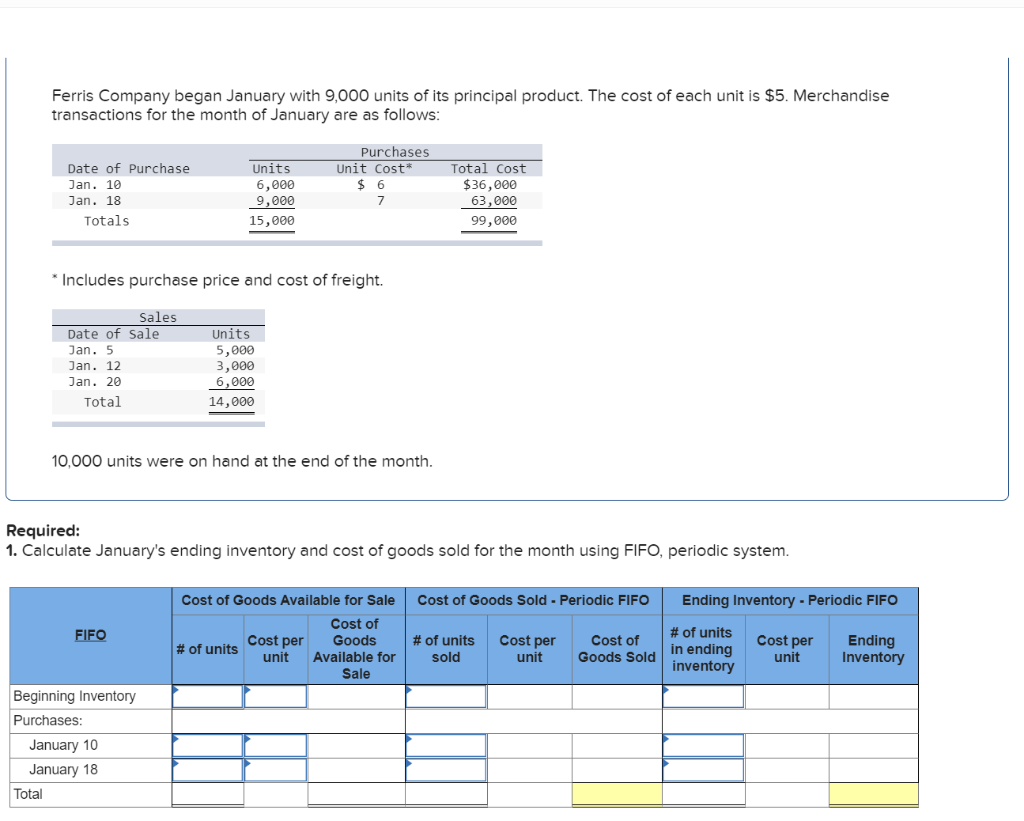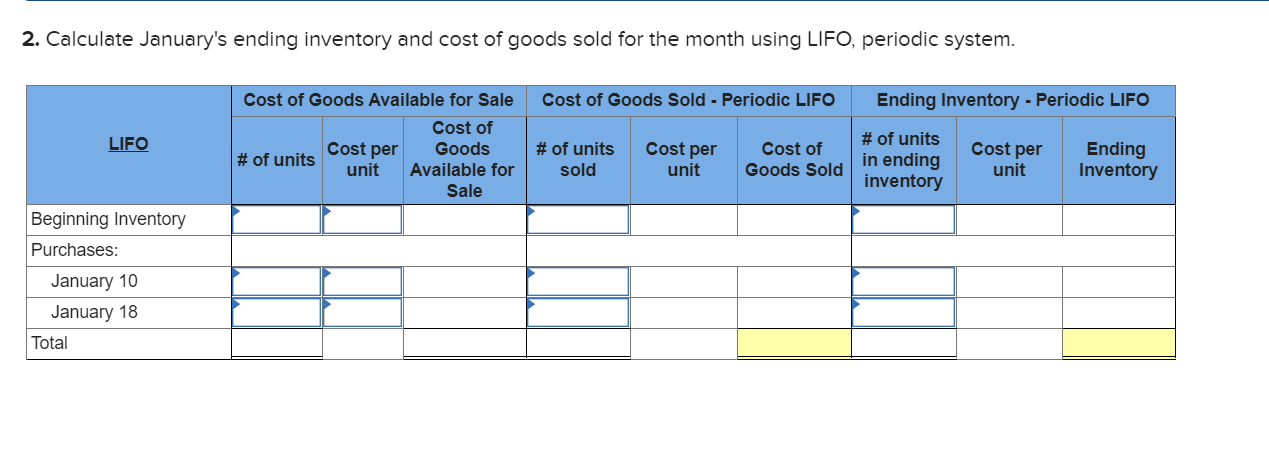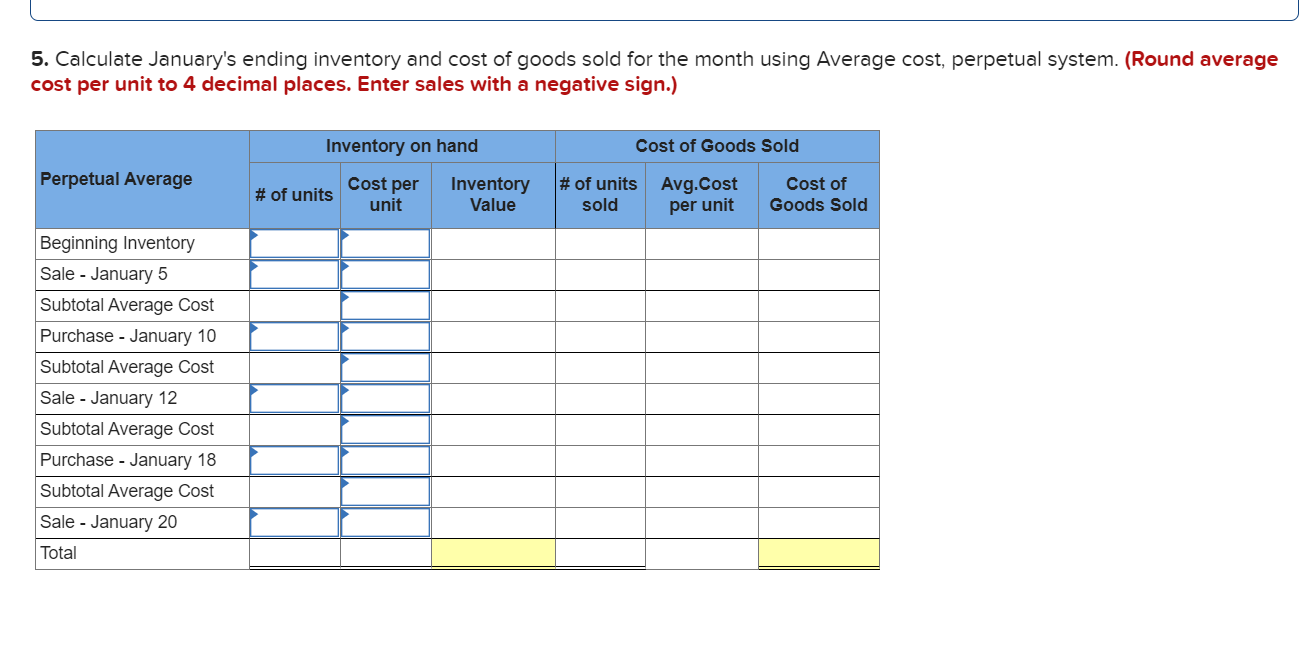




Ferris Company began January with 9,000 units of its principal product. The cost of each unit is $5. Merchandise transactions for the month of January are as follows: Date of Purchase Jan. 10 Jan. 18 Totals Units 6,000 9,000 15,000 Purchases Unit Cost* $ 6 7 Total Cost $36,000 63,000 99,000 * Includes purchase price and cost of freight. Sales Date of Sale Jan. 5 Jan. 12 Jan. 20 Total Units 5,000 3,000 6,000 14,000 10,000 units were on hand at the end of the month. Required: 1. Calculate January's ending inventory and cost of goods sold for the month using FIFO, periodic system. Cost of Goods Sold - Periodic FIFO Ending Inventory - Periodic FIFO FIFO Cost of Goods Available for Sale Cost of Cost per Goods # of units unit Available for Sale Cost of # of units Cost per # of units sold Cost per unit Goods Sold in ending Ending Inventory unit inventory Beginning Inventory Purchases: January 10 January 18 Total 2. Calculate January's ending inventory and cost of goods sold for the month using LIFO, periodic system. Cost of Goods Sold - Periodic LIFO Ending Inventory - Periodic LIFO LIFO Cost of Goods Available for Sale Cost of Cost per Goods # of units unit Available for Sale # of units sold Cost per unit Cost per Cost of Goods Sold # of units in ending inventory unit Ending Inventory Beginning Inventory Purchases: January 10 January 18 Total 3. Calculate January's ending inventory and cost of goods sold for the month using FIFO, perpetual system. Cost of Goods Available for Sale Cost of Goods Sold - January 5 Cost of Goods Sold - January 12 Cost of Goods Sold - January 20 Inventory Balance Perpetual FIFO: # of units Cost per Cost per Cost of Goods Available for Sale Unit Cost # of units sold Cost of Goods Sold # of units sold Cost per unit Cost of Goods Sold # of units Cost per sold unit Cost of Goods Sold # of units in ending inventory Ending Inventory unit unit $ 5.00 $ 0 Beg. Inventory Purchases: January 10 January 18 Total 4. Calculate January's ending inventory and cost of goods sold for the month using Average cost, periodic system. Cost of Goods Sold - Average Cost Ending Inventory - Average Cost Average Cost Cost of Goods Available for Sale Cost of Unit Goods # of units Cost Available for Sale # of units sold Average Cost per Cost of Goods Sold # of units in ending inventory Average Cost per unit Ending Inventory Unit Beginning Inventory Purchases: January 10 January 18 Total 5. Calculate January's ending inventory and cost of goods sold for the month using Average cost, perpetual system. (Round average cost per unit to 4 decimal places. Enter sales with a negative sign.) Inventory on hand Cost of Goods Sold Perpetual Average Cost per # of units Inventory Value # of units sold Avg.Cost per unit Cost of Goods Sold unit Beginning Inventory Sale - January 5 Subtotal Average Cost Purchase - January 10 Subtotal Average Cost Sale - January 12 Subtotal Average Cost Purchase - January 18 Subtotal Average Cost Sale - January 20 Total











